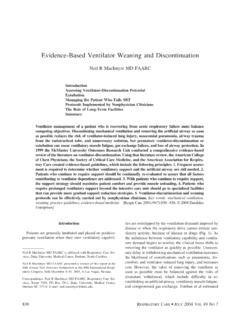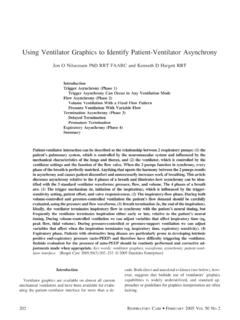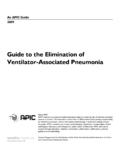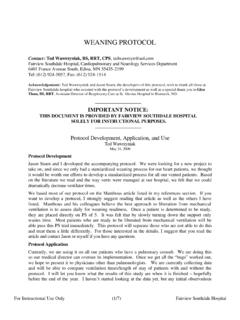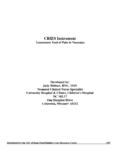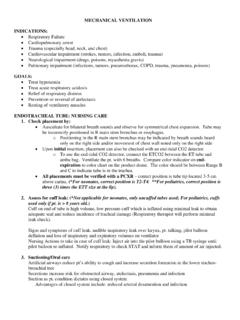Transcription of Weaning With Indirect Calorimetry - GE Healthcare
1 1/3 C l i n i c a l P a p e rWeaning with Indirect CalorimetryChris L. Harris RRCP, RRTC linical Leader Respiratory TherapyLondon Health Sciences Centre, University CampusLondon, Ontario, CanadaEmail: metabolic measurements by IndirectCalorimetry for determining oxygen consumption (VO2)and carbon dioxide production (VCO2) has increased inpopularity among clinicians since the early 1980 only have the methods of obtaining thisinformation improved, but also the accuracy of thedevices has become more reliable [1,2]. Fromanalyzing expiratory gases with mass spectrometry,and from the more recent technology utilizing mixingchamber like in the DeltatracTM (Datex-Ohmeda),metabolic monitors have now evolved to a small,bedside module enabling the bedside clinician to haveaccurate metabolic measurements for a wide variety ofclinical Information can be obtained?
2 The patient s energy expenditure can be determined byinserting gas exchange measurements into anequation developed by Weir [3]. The informationgathered by Indirect Calorimetry not only determinesthe resting energy expenditure (REE) as a guide toappropriate nutritional support, but also allows theclinician to tailor ongoing nutritional support to meetthe patient s need [4]. with subsequentmeasurements, adequacy and appropriateness canfurther be evaluated. In addition to the nutritionalinformation, the relationship between oxygen delivery(DO2) and VO2 can be assessed, as can the cost ofbreathing. These can be used as a guide to weaningsuccess and outcome [4].Since 1919, the Harris-Benedict Equation [5] hasbeen used to predict a normal, nourished individual sREE, but this is unreliable in the malnourished patient[6].
3 Correction factors have been developed for variousclinical conditions [7]. However, these values areapproximations, and have been based onmeasurements of healthy individuals, not the criticallyill patient. Elevated energy expenditure and a negativenitrogen balance on the other hand usuallycharacterize Intensive Care Unit patients. These twovalues correlate with the severity of illness and theextent of for Metabolic MonitoringDespite all of the advances in metabolicmeasurements, several clinical and physiologicalfactors can influence the results of the gas exchangemeasurements. Some of the guidelines to beconsidered include: A steady state condition must be present toensure that the gas exchange measurement isequivalent to the tissue gas exchange As Haldane Transformation is used in the VO2calculations, monitoring should be limited topatients using less then 60% oxygen.
4 A stable FiO2 must be achieved. Air leaks around endotracheal tubes or throughchest tubes may result in false values. Metabolic monitors require routine calibration toensure accuracy [8].2/3 Metabolic monitors of the past were large andcumbersome, as they measured expired respiratorygases collected in a mixing chamber. They requiredvarying stabilization times to achieve accurate dataafter a change in gas concentration [9]. Paramagneticoxygen sensors could be used to measure the FiO2 andFeO2 values, and an infrared sensor to measure development of a bedside metabolic module (M-COVX) for a critical care patient monitor has replacedthe need of collecting gases in a sample chamber. Thisnew technology uses a mathematical integration offlow and time synchronized continuous gas new module has been shown to be comparable tostandard metabolic monitors [1].
5 How can Indirect Calorimetry contribute toweaning?Malnutrition is a common entity in the critically illpatient [10]. Severe malnutrition is associated with areduction in the strength of respiratory muscles. Thismay lead to ventilatory dependence, increased risk ofinfection, and an increase in hospital morbidity andmortality. Overfeeding can result in metabolic, hepatic,and cardiopulmonary complications, includinghypercapnia and increased minute ventilationrequirements, which reduce the ability to wean. Sincethe Respiratory Quotient (RQ) is the ratio of VCO2/VO2,we can determine what energy sources are at , which results in the use of endogenousfat stores, should result in decreases in the promotes lipogenesis, which can cause anincrease in the RQ.
6 with the additional measurementof urinary urea excretion, the distinction betweenprotein oxidation and the relative contributions of fatand carbohydrates can be determined. Optimizing apatient s nutritional status prior to a Weaning trialincluding the composition and amount of feeding cancontribute to overall initiating a Weaning trial and incorporatingindirect Calorimetry , continuous measurements of theVO2 and VCO2 are available. with these values beingmonitored, reductions in ventilator support can beimplemented while observing the VO2 for an increase inthe oxygen cost of breathing [11]. When monitoring apatient s increase in minute ventilation, considerationof the reason for the acute increase in ventilatorydemand must be determined.
7 For example, thisincrease may be as a result of increase VCO2 and/or anincrease in lung dead space (Vd/Vt). The reason foreach variable may lead to a further understanding ofwhy the patient is unable to wean from the Bedside monitoring of accurate gas exchange incritically ill patients is now possible. Although the initialdevelopment of metabolic monitors was for monitoringnutritional regimes, today s technology allows for manypotential areas for diagnostic and therapeuticmodalities. In fact, there are new opportunities toinvestigate the information measured for ventilatorymanagement of the patient. with the progression ofnew and varied ventilators and modes, permissivehypercapnia, and protective lung strategies, moreresearch is required to validate the applicability ofindirect Calorimetry in each of these areas, and toutilize this technology to its fullest McLellan S, Walsh T, Lee A.
8 Clinical evaluation of anew gas exchange monitor in mechanicallyventilated patients. Abstracts of the 12th ESICMA nnual congress (Berlin, Germany). Intensive CareMed. 1999; 25, Suppl. 1:S62. Wells JC, Fuller NJ. Precision and accuracy in ametabolic monitor for Indirect Calorimetry . Eur JClin Nutr 1998 Jul; 52(7): 536-403. de V Weir JB: New methods for calculatingmetabolic rate with special reference to proteinmetabolism. J Physiol 1949; 109: 1-94. AARC Clinical Practice Guideline. MetabolicMeasurement using Indirect Calorimetry duringMechanical Ventilation, Respir Care 1994:39(12): 1170-11755. Harris JA, Benedict FG: A Biometric Study of BasalMetabolism in Man. Washington DC, CarnegieInstitute of Washington, Publ 279, 19196.
9 Roza AM, Shizgal HM: The Harris-Benedictequation reevaluation: Resting energyrequirements and the body cell mass. Am J ClinNutr 1984; 40: 168-1827. Bursztein S, Elwyn D, Askanazi J, Kinney J: EnergyMetabolism, Indirect Calorimetry , and Nutrition(pp. 17-21). Williams and Wilkins, 19898. Brandi LS, Bertolini R, Calafa M, IndirectCalorimetry in Critically Ill patient: ClinicalApplications and Practical Advice, Nutrition 1997;13: 349-358,9. Brandi LS, Bertolini, R, Santini L, Cavani S: Effectsof Ventilator Resetting on Indirect Calorimetrymeasurement in critically ill surgical patient, CritCare Med 1999; 27(3): 459-60,3/3 10. Driver AG, Le Brun M, Iatrogenic malnutrition inpatients receiving ventilatory support.
10 JAMA 1980;244-219511. Mitsuoka M, Kinninger KH, Jacobson KL,JohnsonFW, Burns DM: Utility of measurement ofoxygen cost of breathing in predicting success orfailure in trials of reduced mechanical ventilatorysupport. Resp Care0303 2003 Datex-Ohmeda Division Instrumentarium Corp. All rights reserved. Subject to change without , Ohmeda and other trademarks are property of Instrumentarium Corp. or its subsidiaries. All other product and company names are property of their respective owners.
